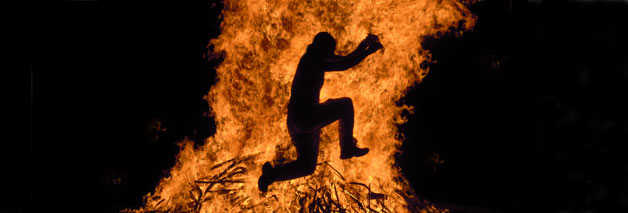Perhaps one of the most defining things that separate humans from the rest of the animal world is our command of fire. Fire is essential to who we are and how we have developed as a species. Indeed, it has been suggested that our taming of fire, and our development of cooking, is what let us evolve to Homo sapiens. Thus, it is no surprise that fire is a key element in Basque culture. Several expressions highlight the central role of fire to the Basques: su bako etxea, gorputz odol bagea – a home without fire is like a body without blood; sua eta ura morroi onak, nagusi gaiztoak – fire and water are good servants, but bad masters. But fire’s role goes beyond a few nuggets of wisdom.

- At one time, the population was counted not by person, but by the number of fires, or families, in the province. A house could have more than one fire, and thus more than one family (a large baserri or caserio could house more than one family, sort of duplex style). The Book of Fires, from 1366 in Nafarroa, counted 18,219 fires in the province.
- The Fueros of Nafarroa stipulated that, particularly in towns that were short of firewood, neighbors had to share fire, with strict guidelines on how the fire of the hearth had to be maintained and how the one who needed fire, with a pot of straw, was to take away their own embers.
- Until the end of the 19th century, most domestic fire was produced using flint and tinder, where the tinder was made, at least in Gipuzkoa, from beech trees. The tinder would be cooked with water in ash and then dried completely. This tinder could be easily lit with sparks from a flint. With the advent of matches, this method quickly disappeared.
- The kitchen fire is central to the concept of home and was considered a supernatural spirit, symbolizing the home and serving as a vehicle to ancestors. Many favors, including aiding the second teething of children, purifying foods, and consecrating outside people and animals into the house, were asked of the fire. If one wanted to attract a new person into the family and house, they would walk around the fire. Every year, at Christmas Eve, the fire would be renewed with a new log.
- Fire was also used to announce the death and burial of people in the home. Fires were lit either at the crossroads near the home or at the doorway, heralding the burial of a family member.
Auñamendi Entziklopedia. FUEGO. Available at: https://aunamendi.eusko-ikaskuntza.eus/en/fuego/ar-63200/


One thought on “Basque Fact of the Week: Fire and Flame in Basque Culture”